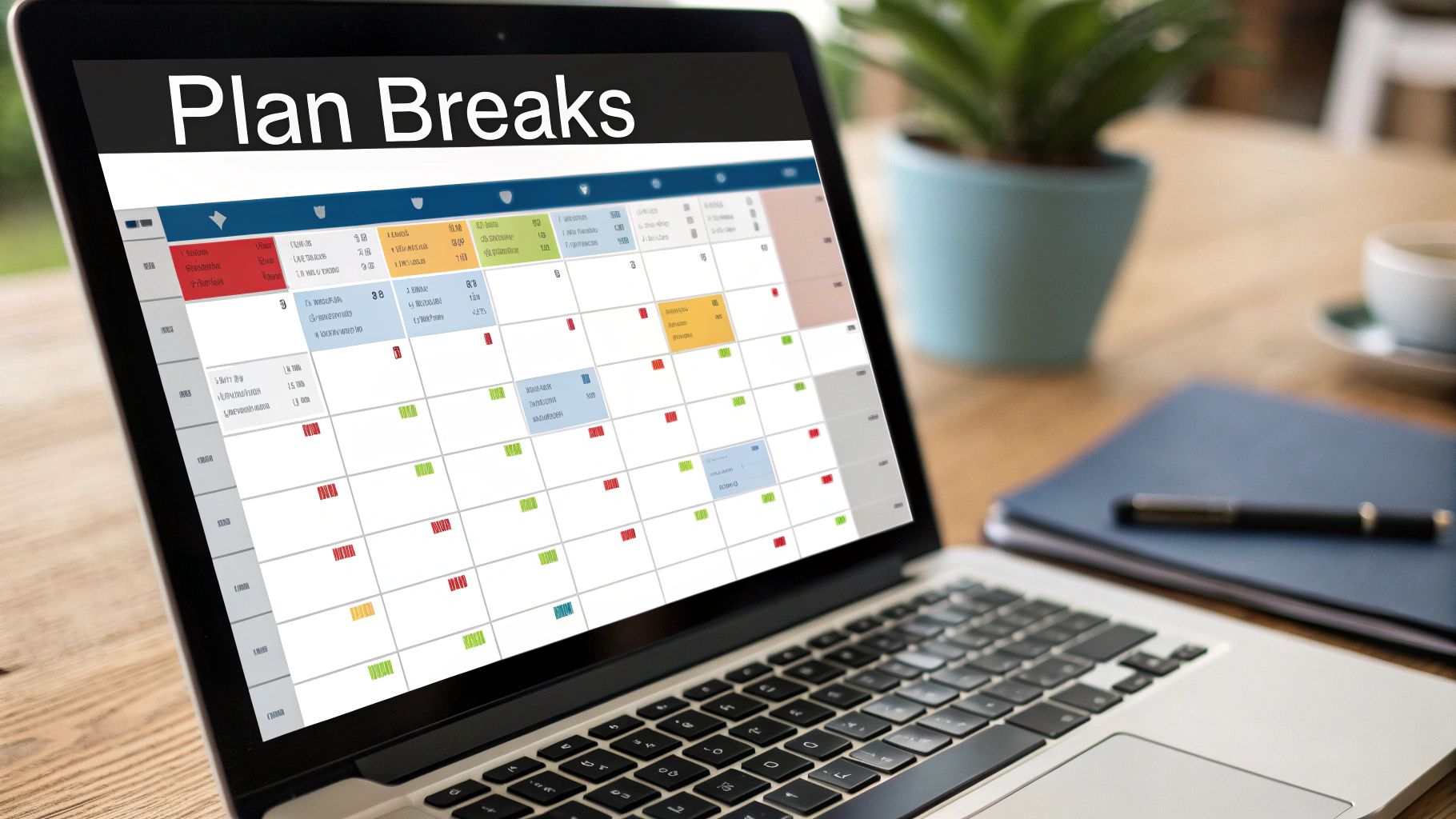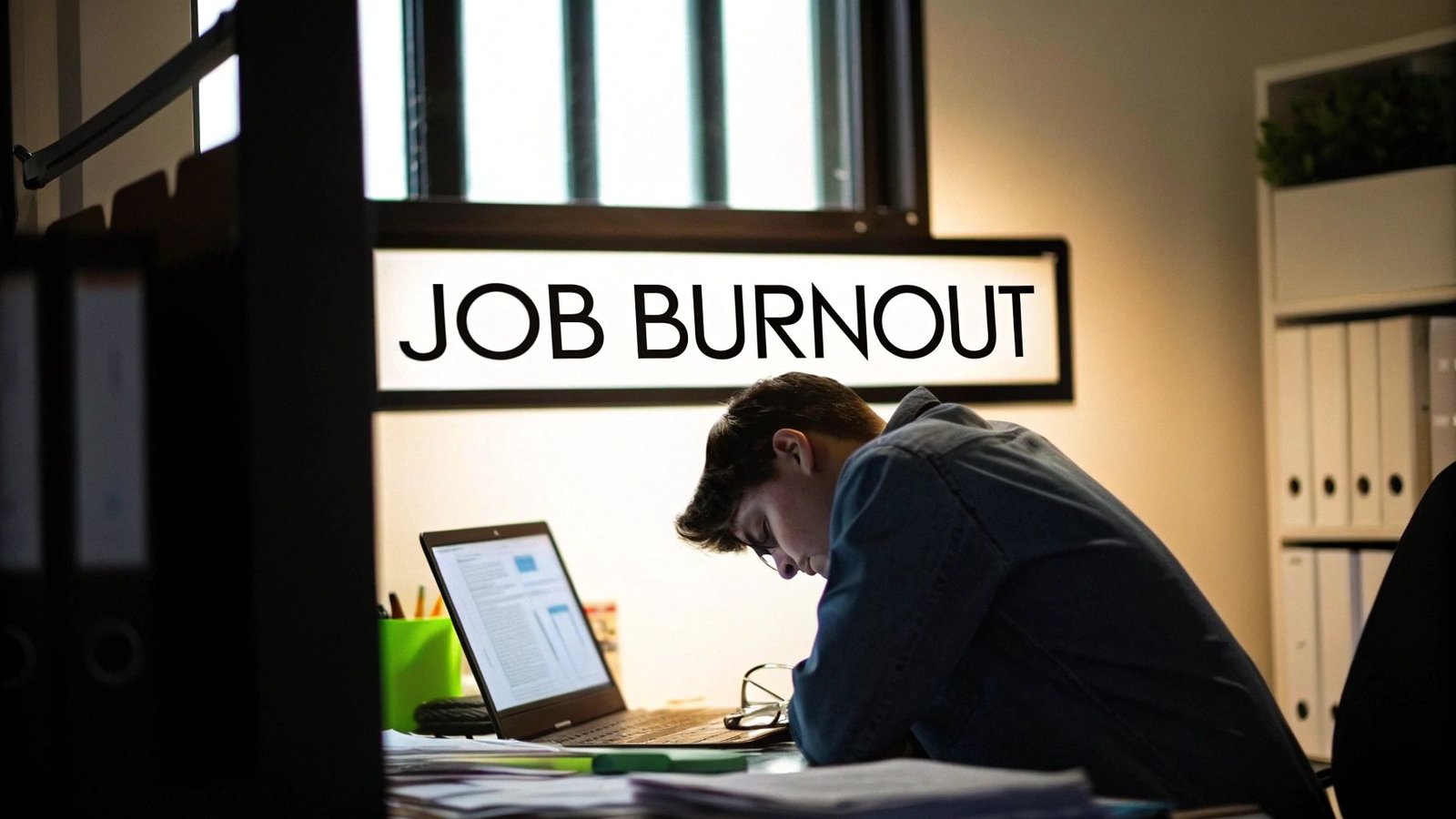Understanding the True Impact of Burnout

Burnout goes far beyond everyday stress. It's a complete depletion of your emotional, physical, and mental energy that leaves you feeling cynical and unfulfilled. Think of it like trying to sprint through a marathon – eventually, your body and mind hit a wall. The key difference between normal work pressure and true burnout lies in the persistent feeling of hopelessness, where nothing you do seems to make things better.
Recognizing the Signs of Burnout
The early warning signs of burnout often creep up slowly, making them easy to miss or dismiss. Physical symptoms typically show up first – you might feel constantly tired even after sleeping well, get frequent headaches, or notice your muscles are always tense. The mental toll follows close behind, showing up as irritability, trouble focusing, and feeling disconnected from others. These changes can strain both your work relationships and personal life, making it harder to find joy in activities you once enjoyed.
The Devastating Effects on Performance and Well-being
When burnout takes hold, it creates a snowball effect that touches every aspect of your life. Your work quality drops, mistakes increase, and that only feeds into feelings of not being good enough. The health risks are serious too – research links burnout to higher chances of heart disease, type 2 diabetes, and depression. A recent study by isolved found that 71% of employees say burnout affects their work performance, with many just going through the motions at their jobs. The most effective solutions? Companies that offer paid mental health days and direct support for struggling workers. You can learn more about burnout's impact on employees here. Understanding these far-reaching effects is essential for creating healthier workplaces that support both individual and team success.
The Leadership Connection: Breaking the Burnout Cycle

Leadership brings both rewards and challenges. When leaders face sustained pressure without adequate support, burnout becomes a real risk – not just for them, but for their entire team. A leader experiencing burnout struggles to provide the guidance and motivation their team needs, creating a ripple effect throughout the organization. This makes addressing burnout at the leadership level essential for maintaining a healthy workplace.
Recognizing Burnout in Yourself and Your Team
Spotting burnout requires paying attention to subtle changes in behavior and mindset. For leaders, common warning signs include:
- Difficulty with basic decision-making
- Unusual irritability with team members
- Feeling disconnected from work responsibilities
Watch for similar patterns in your team members too. A drop in productivity, more frequent absences, or a shift toward negativity often signal that someone is struggling. Catching these signs early allows you to step in with support before burnout becomes severe.
Effective Delegation and Support Systems
Strong leaders know they can't do everything alone. Good delegation isn't about simply handing off tasks – it's about giving team members opportunities to grow while maintaining clear communication and providing necessary resources. Building support networks is equally crucial. This can include:
- Setting up mentoring partnerships
- Creating peer support groups
- Ensuring access to mental health resources
These support structures show employees that their wellbeing matters, helping create an environment where people can thrive.
Recent research highlights just how widespread burnout has become. According to a Hubstaff study, 53% of managers report experiencing burnout. Those feeling exhausted are 1.8 times more likely to leave their position. Even more concerning, managers dealing with cynicism or reduced confidence in their work are 3.0 to 3.4 times more likely to quit.
Leading by Example: Prioritizing Well-being
As a leader, taking care of yourself isn't selfish – it's necessary. This means setting clear work-life boundaries, making time for self-care, and modeling sustainable work habits. When leaders openly prioritize their own wellbeing, it gives team members permission to do the same. The result? Higher engagement, better performance, and a more positive workplace culture built on mutual support rather than constant pressure.
Building a Culture of Sustainable Energy

Successfully preventing burnout requires more than just individual coping strategies – it needs a complete rethinking of workplace culture. Forward-thinking companies are making employee wellbeing just as important as hitting business goals. This means looking at everything from how we recognize good work to the policies that protect mental health.
Fostering a Sense of Belonging and Recognition
When people feel truly valued at work, they're much less likely to burn out. Good recognition goes beyond basic rewards – it's about acknowledging people's unique contributions in ways that matter to them. Some effective approaches include:
- Personal thank you notes highlighting specific achievements
- Sharing team and individual wins during meetings
- Offering growth opportunities based on people's interests
- Creating safe spaces for honest feedback and new ideas
Creating Authentic Support Networks
Having strong relationships at work helps everyone handle stress better. The best support systems grow naturally through regular interaction and shared experiences. Companies can help by:
- Setting up informal mentoring pairs
- Planning team activities that let people connect personally
- Creating employee groups around shared interests or experiences
Recent research backs this up – the SHRM Employee Mental Health Research Series found that employees who feel they belong at work are 2.5 times less likely to experience burnout. Similarly, those who can be themselves at work are 2.5 times less likely to feel emotionally drained. See the full SHRM research findings.
Implementing Policies That Protect Mental Health
Company policies set the tone for how seriously mental health is taken. Key areas to focus on include:
- Clear boundaries around work hours and availability
- Easy access to mental health resources and support
- Flexible work options that fit different needs
- Regular mental health days and encouragement to use them
To make sure these changes actually help, companies need to track their impact. This means regularly checking in with employees, watching trends in sick days and turnover, and adjusting approaches based on feedback. When organizations commit to measuring and improving their mental health support, they create workplaces where people can truly thrive.
Mastering Daily Energy Management

Managing your daily energy, not just your time, is key to beating burnout. Think of your energy like a bank account – you need to make wise deposits and withdrawals throughout the day. When you work with your natural energy patterns instead of against them, you can get more done while feeling less drained. This simple shift in approach makes a real difference in preventing and recovering from burnout.
Identifying Your Peak Performance Windows
Everyone has certain times of day when they feel most alert and focused – these are your peak energy windows. For early birds, this might be first thing in the morning, while night owls may hit their stride after dark. Start by keeping track of when you feel most productive. Note your energy levels at different times for a week or two. Then match your most challenging work to these high-energy periods.
Designing Routines for Optimal Energy Flow
Once you know your peak times, build your schedule around them. Save your best hours for deep, focused work. Schedule meetings and lighter tasks for when your energy naturally dips. For example, if you tend to slow down after lunch, use that time for admin work or take a short walk to recharge. This way, you're working smarter by matching tasks to your natural energy patterns.
Implementing Effective Recovery Practices
Real recovery means doing activities that actually restore your energy, not just pass the time. While it's tempting to unwind with social media or TV, these usually don't provide deep recharging. Instead, focus on activities that truly refresh you – maybe it's exercise, meditation, time outdoors, or diving into a hobby you love. The key is choosing activities that leave you feeling energized, not drained.
Stress Management and Energy Conservation
Stress eats up your energy like nothing else. Simple techniques like deep breathing or short meditation breaks can help you save energy throughout the day. Learning to say "no" to tasks that aren't essential is equally important – it prevents overwhelm and helps maintain steady energy levels. Remember, your energy is limited, so spend it wisely on what matters most.
Examples of Successful Energy Management Systems
Many people find success with specific methods to manage their energy. The Pomodoro Technique helps you work in focused 25-minute chunks with short breaks in between. Timeboxing involves setting aside specific blocks of time for different tasks. Try out different approaches to find what fits your work style best. The goal is finding a system that helps you maintain steady energy while avoiding burnout.
Setting Boundaries That Transform Your Work Life
Creating healthy boundaries helps prevent burnout and allows you to build a sustainable career. Think of boundaries as personal guidelines that protect your time, energy, and wellbeing. While setting limits can feel uncomfortable at first, especially in demanding work environments, they're essential for long-term success and avoiding exhaustion.
Communicating Your Limits Effectively
Being clear and professional about your boundaries makes a big difference. Instead of being apologetic or aggressive, aim for direct and respectful communication. For example, if late-night work becomes an issue, try saying: "I'm fully committed during work hours of 9-6 PM. For urgent matters after hours, I'll address them first thing the next morning."
Remember that maintaining boundaries takes ongoing effort. You may need to remind people of your limits multiple times, especially those who regularly test them. Stay consistent with your message.
Managing Expectations Proactively
Set clear expectations early – it's much easier than trying to change them later. When starting new projects or roles, explain your work style upfront. Share details like your typical email response time and preferred contact method for urgent issues. This helps prevent misunderstandings before they start.
Learning to say "no" is another key skill. When you're at capacity, it's perfectly fine to decline new requests. Keep your response brief and professional: "Thank you for thinking of me. Given my current project load, I won't be able to take this on and give it the attention it deserves." This protects your existing commitments and mental health.
Handling Boundary-Pushers With Confidence
You'll likely encounter people who test your limits. Stay calm and firm without becoming defensive. Have ready responses for common situations. If someone regularly sends late-night messages, you might say: "I've noticed you often email after hours. Since I check messages during business hours, you can expect my response then."
Strategies for Digital Boundary-Setting
Clear digital boundaries matter just as much as in-person ones. Try these practical approaches:
- Set specific times for checking work messages and emails instead of being always available
- Be upfront about response times so colleagues know what to expect
- Keep work and personal social media separate to maintain healthy life boundaries
Creating a Sustainable Work-Life Integration
Perfect work-life balance might not exist, but work-life integration offers a practical alternative. This means finding ways to blend work and personal priorities that fit your life. Maybe that's blocking time for family dinners, taking exercise breaks during the day, or working remotely part-time. Focus on creating routines that support both your career goals and personal wellbeing.
By establishing clear boundaries and managing your energy wisely, you build a career that's both rewarding and sustainable. These boundaries aren't just good for preventing burnout – they help you do better work and enjoy life more fully.
Creating Your Burnout Recovery Blueprint
Getting back on track after burnout requires a thoughtful, long-term approach. Just like you'd plan a major home renovation, you need a solid strategy to rebuild your energy and prevent future burnout. This means taking an honest look at where you are now, understanding what drains you, and creating specific steps for positive change.
Conducting a Personal Energy Audit
Start by tracking exactly where your energy goes each day. Keep a simple log for a week, noting how different activities and interactions affect you. Do certain meetings always leave you exhausted? Is there a specific time of day when you hit a wall? These patterns help pinpoint what's really causing your burnout, rather than just guessing at the problem.
Developing an Early Warning System
Your body and mind often signal burnout long before a full crash. Learn to spot your personal warning signs – maybe you start skipping lunch, snapping at coworkers, or lying awake at night. When you notice these red flags, you can take action early. For example, if you catch yourself working through weekends, that's a clear sign to schedule some real downtime.
Building Resilience Through Lifestyle Adjustments
Strong resilience comes from consistent, healthy habits. Focus on making practical changes that support your wellbeing:
- Quality Sleep: Make 7-9 hours of rest your non-negotiable priority
- Regular Movement: Find physical activities you actually enjoy
- Nourishing Food: Choose meals that give you steady energy
- Stress Management: Practice simple techniques like deep breathing or short walks
The key is making these changes stick by working them naturally into your daily routine, rather than treating them as temporary fixes.
Measuring Progress and Adjusting Your Approach
Recovery rarely follows a straight line. Check in with yourself regularly – are you feeling more energized? More present at work and home? If something isn't working, be ready to try a different approach. You might need to adjust your work boundaries, try new stress-relief methods, or get support from a counselor. Like any good plan, yours should flex and adapt based on real results.
Maintaining Momentum During High-Pressure Periods
Busy times will still come up. The difference is having specific strategies ready when they do:
- Share the load by delegating where possible
- Be clear about your limits with colleagues and clients
- Take mini-breaks to reset throughout the day
- Focus on what matters most and let go of less important tasks
These practical steps help you handle pressure without sliding back into burnout. The goal is maintaining your wellbeing even when work demands increase.
Ready to take control of your career and build a future aligned with your values? CareerTruth offers a proven framework for navigating career challenges, overcoming burnout, and achieving lasting success. Visit CareerTruth today to discover how we can help you transform your career journey.


